Time trends and disparities of obesity and related national policies and programs in Nepal:a systematic review
作者机构:Department of ObstetricsNorthwest Women's and Children's HospitalXi'anShaanxiChina School of Economics and FinanceXi'an Jiaotong UniversityXi'anShaanxiChina Center for Non-Communicable Disease ManagementBeijing Children's HospitalCapital Medical UniversityNational Center for Children's HealthBeijingChina Global Health InstituteNo.21 Hongren BuildingWest China Science and Technology lnnovation Harbour(iHarbour)Xi'anShaanxiChina School of Public HealthXi'an Jiaotong UniversityXi'anShaanxiChina
出 版 物:《Global Health Journal》 (全球健康杂志(英文))
年 卷 期:2024年第8卷第2期
页 面:46-57页
学科分类:1002[医学-临床医学] 100201[医学-内科学(含:心血管病、血液病、呼吸系病、消化系病、内分泌与代谢病、肾病、风湿病、传染病)] 10[医学]
主 题:Nutrition transition Overweight Obesity Obesity prevention Systematic review Nepal
摘 要:Objective Overweight and obesity prevalence has increased in low-income *** study systematically reviewed the obesity trend,disparities,and prevention and control efforts in *** We searched PubMed and Google Scholar for articles and reports published between January 1,2004 and December 31,*** information on National policies and programs related to obesity prevention was retrieved from governmental websites and consultation with relevant *** and obesity were defined using the World Health Organization body mass index cut ***-two studies and reports were *** Overall,overweight and obesity rates increased in all groups in Nepal although nationally representative data remained *** combined overweight and obesity(OW/OB)and obesity rates in women aged 15-49 years increased from 8.5%to 22.2%and from 0.9%to 5.1%between 2006 and 2016,***/OB and obesity rates in men were 17.1%and 2.5%based on data from the 2016 Demographic and Health ***/OB rate in under-five children increased from 0.6%to 2.8%between 2006 and *** rates for school-age(5-9 years)boys and girls in 2016 were 2.4%and 2.8%,respectively,and were 1.1%and 1.4%for male and female adolescents aged 10-19 years,***/OB prevalence was much higher among women,residents in urban areas and central provinces,and in higher socioeconomic status *** prevalence of OW/OB and obesity for 2030 in adults aged 15-49 was 44.7%and 8.3%,respectively,while it was 2.2%for OW/OB in preschool *** and direct interventions that specifically focused on obesity prevention and control are *** OW/OB prevalence in Nepal has increased during the past 1.8 decades,disproportionately affecting population *** interventions mostly focused on undernutrition with some indirect implications for obesity *** the future,Nepal needs to develop population-based programs for obesity



